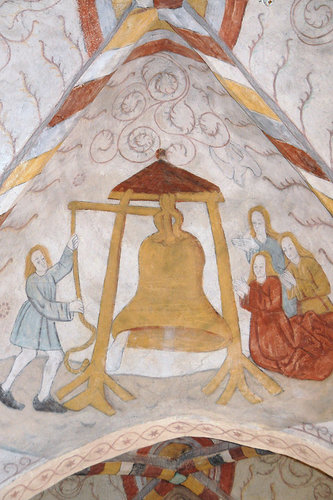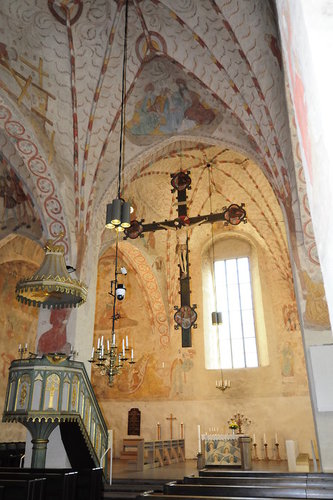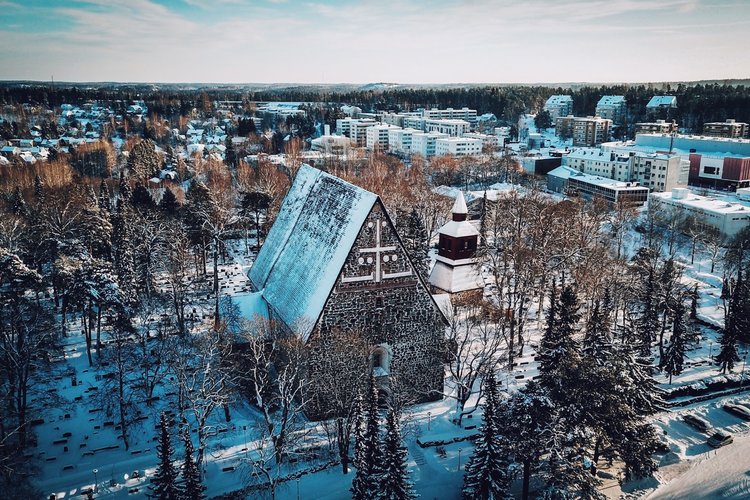Evästeet
EvästeetLinkki avautuu uudessa välilehdessä
The Church of St. Lawrence is the 3rd largest medieval church in Finland. Only Turku cathedral and Nådendal abbey’s church are larger. The church is first mentioned in written documents in the year 1382. The rich medieval paintings inside on the church vaults and walls, dating back to the early 16th century, make St. Lawrence’s one of the most significant medieval monuments. The painting work was probably paid by Tönne Eriksson Tott who was a stadtholder of Raseborg between 1490 and 1513. Researchers think that it’s possible that an earlier church made of wood once stood on the same place right after the founding of the parish in the 1230s or 1240s.’
The base of the bell tower, which also dates back to the Medieval era, is built of stone in the same style as St. Lawrence’s church. The rest of the belltower is built of wood under the supervision of German build master Friedrich Schultz in 1740. The tower holds three bells; the largest bell was made in Lohja in 1624, the middle one was made in Tallinn in 1594 and the smallest bell was made in 1740 in Stockholm.
St. Lawrence’s church was decorated with biblical paintings between 1510 and 1522. It’s not known to us exactly who the painter was, or which group painted the church. By the style of the paintings, it’s commonly thought that the paintings might be made by someone influenced by the Swedish painter Albertus Pictor.
Earth pigments were used in the painting process which follows the al-secco method. The colors were painted on dry plaster, so the paintings are not frescos. The images are painted following the instructions given by the Cathedral Chapter of Turku. The image series start on the right-hand side of the altar (looking from the parish members’ perspective) with the history of the creation. The series ends with the last judgment on the left-hand side of the church. Images of saints were painted on the pillars of the church. A certain kind of Finnishness shows in the paintings; Adam and Eve are covering themselves with a bath broom instead of Ficus leaves.
The series of murals, painted al secco, follow a definite sequence, primarily the chronological
sequence of the ecclesiastic year, with the events of the Old and New Testament intertwined.
The narrative series of pictures begins from the right of the chancel, with compositions depicting the
creation of the world and the garden of Eden. The narrative continues clockwise around the church until it ends with the Last Judgment, on the left of the chancel. The focus of the narrative is the Passion Story mural at the western end of the church.
The running narrative of the murals is complemented by illustrations of the lives of Apostles and Martyrs on the pillars and in the webs of vaults. The decorator is not known by name but he is believed to have been of the school of Albert the Painter (ca. 1440‑1509), the Swedish church decorator.

Only a few wooden sculptures have survived from the medieval furnishings of the church. The most remarkable is the rood between the chancel pillars, believed to be a Finnish sculptor's work from the late 15th century. A sculpture of the Patron Saint of the church of Lohja, St. Lawrence, dating back to the early 15th century, hangs on the southern wall.
The brass chandeliers date back to the 17th and 18th centuries. The altar is decorated by a large seven‑branched candelabra dated 1737. The hourglass of the pulpit is of approximately the same age. The hymn board by the sacristy door, in Rococo style, dates back to 1766.
A cast‑iron coverplate of the brick tomb of Thomas Paccalenius ‑ the parson of Lohja in 1762‑84 ‑ and his wife is placed in the floor of the chancel.
Another tomb of the 18th century is close to this, a votive stone procured by G. A. Söderholm, a local judge, for his wife, and attached to the eastern wall of the chancel. In the floor to the right of the altar there is a memorial slab donated in 1968 by the Rennerfelt family. The only fixture of the church remaining from the 19th century is the Neogothic pulpit of 1845.

The latest extensive repairs to the church were carried out in two phases. In 1955‑1957, Oskari Niemi restored the ornamental paintings liberating the vault and wall surfaces from the superimposed paintings of the 1880s. The westernmost vault of the middle nave has been preserved as an example of the method of restoration as practised in the last century. Architectural restoration and repairs were carried out in 1966‑68 under plans drawn up by Professor Esko Järventaus. In this connection, all windows and doorways were restored to their original shape.
The main organ of the church was built in 1985 by organ builder
Veikko Virtanen from Espoo. There is 3 manuals and pedal with 36 stops in the main organ. The chancel organ with 7 stops was built in 1986.
The belfry in the churchyard has a lower part of
mediaeval origin while the wooden upper part dates back to the 1740s. The mortuary chapel next to the belfry was built in 1824. Another chapel building, off the western end of the church. is of approximately the same age.

A 24h CCTV in operation for your safety. The church is equiped with smoke detectors and a defibrillator. Smoking in the area is not permitted. In an unlikely case of an emergency it is important to follow the orders given by the staff and the authoroties. This church has 3 emergency exits and they are all marked with green exit signs.
RESCUE the ones in danger
CALL emergency number 112
INFORM the staff
EXTINGUISH using the nearest fire extinguisher
GIVE FIRST-AID to ones in need
LEAD the rescuers to the site
EvästeetLinkki avautuu uudessa välilehdessä